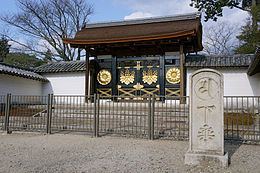 | ||
Similar Daigo‑ji, Daigo Station, Zuishin‑in Temple, Kajū‑ji, Ninna‑ji | ||
Fushimi inari shrine kyoto letters from japan
Sanbō-in (三宝院, Sanbō-in) is a Buddhist temple in southern Kyoto, Japan, known today primarily for the quality of its garden.
Contents
- Fushimi inari shrine kyoto letters from japan
- Map of Japan E38092601 1325 KyC58Dto fu KyC58Dto shi Fushimi ku DaigohigashiC58DjichC58D E4B889E5AE9DE999A2
- History
- References
Map of Japan, %E3%80%92601-1325 Ky%C5%8Dto-fu, Ky%C5%8Dto-shi, Fushimi-ku, Daigohigashi%C5%8Djich%C5%8D, %E4%B8%89%E5%AE%9D%E9%99%A2
History
Sanbō-in was established in the Azuchi-Momoyama period (1582–1615). It was a sub-temple of Daigo-ji, which is a Heian period temple founded in 902. The temple complex had fallen into disrepair during the Sengoku period.
A majority of the present buildings and the garden of Sanbō-in date from the late 16th century. The garden is designed as a stroll garden with a large pond and several paths and bridges. The garden is said to contain over 700 stones; and one of them, called the Fujito stone, is said to have cost over 5,000 bushels of rice. Sanbō-in is also a noteworthy illustration of a landscape garden which is designed for viewing from a specific perspective within a building. As laid out in the Momoyama period, the garden remains one of the finest uses of the "fortuitous crane," the "tortoise" and the "isle of eternal youth." These poetic terms identify specific ways in which stones and ponds are poised in a prescribed, esoteric relationship.
In 1598, Toyotomi Hideyoshi redesigned an existing garden in order as avenue for an extravagant cherry blossom-viewing party.
